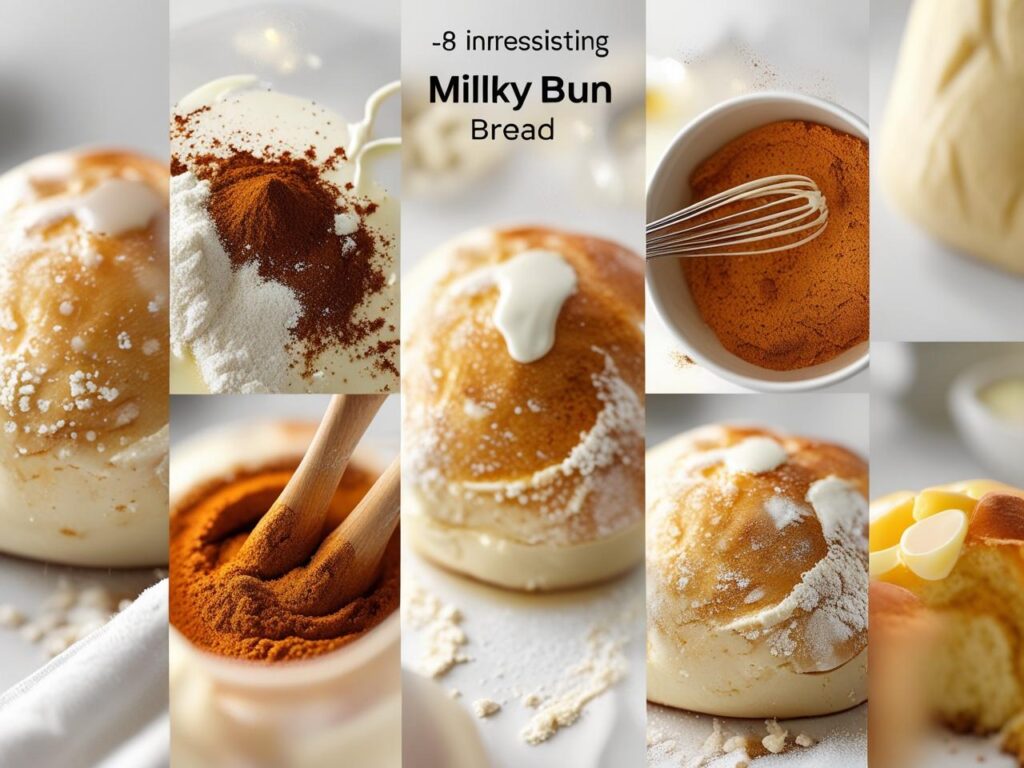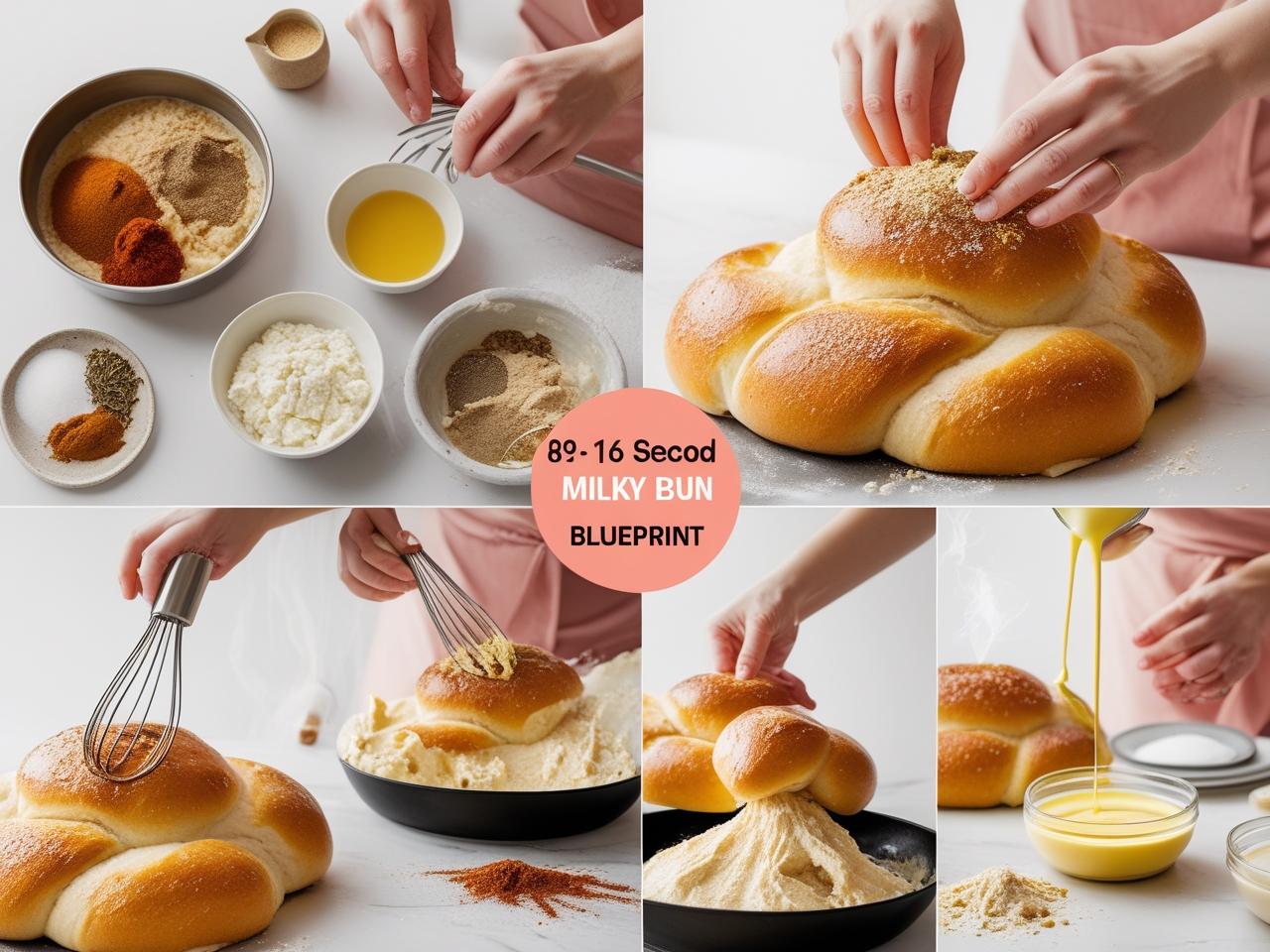Fluffy Clouds of Deliciousness: The Ultimate !
Prepare to experience bread like never before! This Milky Bun Bread, famously known as Japanese Milk Bread, isn’t just soft; it’s exceptionally light, incredibly fluffy, and boasts a delicate sweetness that will melt in your mouth. The secret? A traditional “Tangzhong” (or water roux) starter that locks in moisture, ensuring these buns stay fresh and tender for days. Perfect for sandwiches, dinner rolls, or just a delightful treat with butter, this recipe will transform your home baking!

Recipe: Super Soft Milky Bun Bread (Japanese Milk Bread)
Basic Info:
- Yields: 12 medium buns
- Prep Time: 30 minutes
- Tangzhong Cool Time: 15-20 minutes
- Rise Time (1st Proof): 1-1.5 hours
- Rise Time (2nd Proof): 45-60 minutes
- Cook Time: 18-22 minutes
- Total Time: Approximately 3-4 hours
Ingredients:
For the Tangzhong (Water Roux):
- All-Purpose Flour: 2 tablespoons (15g)
- Milk: ⅓ cup (80ml)
- Water: ⅓ cup (80ml)
For the Main Dough:
- All-Purpose Flour: 2 ½ cups (300g), spooned and leveled
- Granulated Sugar: ¼ cup (50g)
- Active Dry Yeast: 1 ½ teaspoons
- Salt: ½ teaspoon
- Large Egg: 1, room temperature
- Milk: ½ cup (120ml), lukewarm (around 105-115°F / 40-46°C)
- Unsalted Butter: 3 tablespoons (42g), softened to room temperature
For Egg Wash (Optional, for Golden Crust):
- Large Egg: 1
- Milk or Water: 1 tablespoon
Equipment:
- Small saucepan
- Whisk
- Large mixing bowl
- Stand mixer with dough hook (highly recommended) or strong hands for kneading
- Measuring cups and spoons
- Rubber spatula
- Clean kitchen towel or plastic wrap
- 9×13 inch baking pan or baking sheet
- Parchment paper
- Pastry brush (for egg wash)
- Wire rack
Step-by-Step Professional Making Process:
Step 1: Make the Tangzhong (The Secret to Softness)
- Combine: In a small saucepan, whisk together 2 tablespoons of flour, ⅓ cup milk, and ⅓ cup water until smooth.
- Cook: Place the saucepan over medium-low heat. Cook, stirring constantly with a whisk or rubber spatula, until the mixture thickens to a paste-like consistency, similar to a thick gravy or pudding. It should leave streaks on the bottom of the pan as you stir. This typically takes 3-5 minutes.
- Cool: Immediately transfer the Tangzhong to a small bowl and cover it directly with plastic wrap to prevent a skin from forming. Let it cool to room temperature (this can take 15-20 minutes). This step is crucial for the bread’s moistness and softness.
Step 2: Prepare the Main Dough
- Activate Yeast: In the bowl of your stand mixer (or a large mixing bowl), combine the ½ cup lukewarm milk and 1 ½ teaspoons active dry yeast. Let it sit for 5 minutes until foamy, indicating the yeast is active.
- Add Wet Ingredients: To the yeast mixture, add the cooled Tangzhong, large egg, granulated sugar, and salt. Mix gently with a whisk or rubber spatula until just combined.
- Add Flour: Gradually add 2 ½ cups all-purpose flour to the wet ingredients.
Step 3: Knead the Dough
- Initial Mix: If using a stand mixer, attach the dough hook. Mix on low speed until a shaggy dough forms and most of the flour is incorporated.
- Add Softened Butter: Now, add the softened unsalted butter to the dough.
- Knead: Increase mixer speed to medium-low. Knead for 8-10 minutes. The dough will initially be sticky but will gradually become smooth, elastic, and will clear the sides of the bowl. Perform a “windowpane test”: pull a small piece of dough; if you can stretch it thin enough to see light through it without tearing, it’s ready.
- Kneading (By Hand): If kneading by hand, turn the dough out onto a lightly floured surface. Knead vigorously for 15-20 minutes until smooth and elastic.
Step 4: First Rise (Bulk Fermentation)
- Prepare for Rise: Lightly grease a clean large mixing bowl with a little oil. Transfer the kneaded dough to the bowl, turning it once to coat all sides.
- Cover & Rise: Cover the bowl tightly with plastic wrap or a clean kitchen towel. Place it in a warm, draft-free place (ideally 75-80°F / 24-27°C).
- Rise Time: Let the dough rise for 1 to 1.5 hours, or until it has doubled in size.
Step 5: Shape the Buns
- Gently Deflate: Once the dough has doubled, gently punch it down to release the air.
- Divide Dough: Turn the dough out onto a lightly floured surface. Divide the dough into 12 equal pieces. For precise sizes, you can weigh them (approx. 55-60g each).
- Shape Rolls: Take each piece of dough. Flatten it slightly, then pull the edges into the center and pinch them tightly at the bottom to form a smooth, tight ball. Roll it gently between your palm and the counter to ensure a perfect round shape.
- Arrange in Pan: Arrange the shaped buns in a lightly greased 9×13 inch baking pan or on a parchment-lined baking sheet, leaving some space between them. For pull-apart buns, place them slightly closer.
Step 6: Second Rise (Proofing)
- Cover & Rise: Loosely cover the shaped buns in the pan/on the sheet with plastic wrap or a clean kitchen towel.
- Rise Time: Let them rise again in a warm, draft-free place for 45-60 minutes, or until they are visibly puffy, soft, and nearly doubled in size. They should look pillowy and light.
- Preheat Oven: Towards the end of the second rise, preheat your oven to 350°F (175°C).
Step 7: Egg Wash & Bake
- Prepare Egg Wash (Optional): In a small bowl, whisk together 1 egg and 1 tablespoon of milk or water.
- Apply Egg Wash: Gently brush the tops of the risen buns with the egg wash. This will give them a beautiful golden-brown, shiny crust.
- Bake: Bake in the preheated oven for 18-22 minutes, or until the buns are deep golden brown on top and sound hollow when gently tapped on the bottom.
- Cool: Once baked, remove the pan from the oven and immediately transfer the buns (still in the pan or gently lifted out) to a wire rack to cool completely. Cooling on a rack prevents the bottoms from getting soggy.
Step 8: Serve & Enjoy!
- Serve: Once cooled, pull them apart and enjoy! They’re perfect plain, with butter, as sandwich buns, or burger buns. The softness is truly incredible.
Professional Tips for Perfect Milky Bun Bread:
- Tangzhong is Non-Negotiable: Don’t skip or rush the Tangzhong step. It’s the secret to the bread’s incredible softness and ability to stay fresh longer. Ensure it cools completely before adding to the dough.
- Accurate Measurements: Bread baking is a science. Measure your ingredients, especially flour, accurately. A kitchen scale is highly recommended for precision.
- Yeast Activation: Always ensure your yeast is active. Lukewarm milk (not hot!) and the initial foam are key indicators.
- Thorough Kneading: This dough needs good kneading to develop strong gluten, which traps air and creates that fluffy texture. The windowpane test is a great indicator.
- Proper Proofing: Don’t rush the rising times. Let the dough double in size for the first proof and become visibly puffy for the second. A warm, draft-free environment is ideal.
- Don’t Overbake: Bake until golden brown. Overbaking will dry out the buns and make them less soft.
- Cool Completely: While tempting, resist cutting into the buns immediately. Cooling on a wire rack allows steam to escape and prevents a gummy texture, helping them set properly.
- Storage: Store cooled Milky Buns in an airtight container at room temperature for 3-4 days, or freeze for up to 3 months. To revive, warm in a microwave for 15-20 seconds or a low oven for a few minutes.
